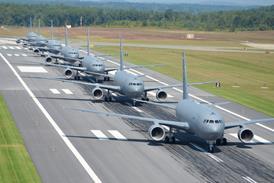No date has been set by Japan and the USA to resume negotiations over the distribution of landing slots at Tokyo's Narita Airport when its long-awaited second runway opens next May. Talks were last held on 26 July but they failed to make progress.
The talks are part of a framework intended to lead to an "open-skies" air services regime between the two countries, but they failed because neither side was willing to compromise. Japan wants to reduce the overall presence of US airlines at Narita by giving other airlines more slots, while the USA wants to maintain the position of its carriers. The meeting was amicable and both sides have agreed to continue talking, says deputy director of the International Air Transport Division of the Japan Civil Aviation Bureau, Hirohisa Tsuruta.
Slots at Narita could potentially rise by up to 50% when the second runway opens.
Japan is concerned a rush to open skies will leave US carriers in a commanding position and reduce competition. Japan is baulking at US demands for the scrapping of caps on carriers and slots at Narita as a step towards open skies.
US carriers currently hold about one-third of Narita's scarce slots. Japanese carriers have only slightly more, leaving few for other airlines and forcing many of them to fly to Osaka's Kansai Airport, Japan's second international gateway.
Japan also wants slots used more efficiently. "Some US carriers use their slots inefficiently. We demand slots be used efficiently, especially as many foreign and Japanese airlines regard them as a precious resource. The USA must understand the pressure Japan faces," says Tsuruta.
Earlier air services agreements gave US carriers their strong position at Narita and the fifth freedom rights they use to reach across Asia. A memorandum of understanding signed in 1998 recorded the desire of both sides to fully liberalise air transport, but has laid out no timetable.
Market forces should decide the allocation of international slots and routes, the USA believes. Other countries disagree, however, as US carriers, in many cases, have been around longer and have a huge domestic market to draw upon.
Source: Flight International























